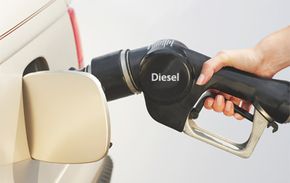Suppose you were to pull up to a gas station in a distracted state of mind. For example, you're driving your three children plus three of their friends to the zoo and they're all screaming for ice cream. As a result of this distraction, you accidentally reach for the diesel fuel nozzle instead of the unleaded gasoline nozzle to fill your tank. What would happen?
Diesel Engine Image Gallery
Advertisement
The first thing to recognize is that this scenario isn't possible in most cars. In any car manufactured in the last 25 years or so, there's a plate under the gas cap that prevents anything but the small unleaded-gasoline nozzle from fitting into the tank. When unleaded gasoline first appeared, this plate helped to prevent drivers from putting the leaded gasoline nozzle in -- the unleaded and leaded nozzles were different sizes. The diesel nozzle is even bigger than leaded nozzles were, so it would never fit in the gas tank of most cars. However, most motorcycles and trucks don't have this plate, so it's easy to make this mistake if you're driving one of those vehicles. And if you're driving an older car, there's no plate either.
So say that you somehow filled a gasoline tank with diesel fuel. If you've ever compared gasoline to diesel fuel, you know that they smell different. They also feel different -- diesel fuel is oily. Like oil, diesel fuel doesn't evaporate like gasoline does. Plus, diesel fuel is heavier. A gallon of diesel is about a pound heavier than a gallon of gasoline.

If you had a gas tank full of diesel fuel, the fuel injectors in your engine would inject the diesel fuel into the engine's cylinders. The spark plugs would fire, but nothing would happen after that. Because the diesel fuel doesn't evaporate very well, the spark plugs would have nothing to ignite, and the engine would never start.
To solve the problem, drain all of the diesel fuel out of the gas tank and refill it with gasoline. Then you would have to keep cranking the engine for a while to get the diesel out of the fuel lines and the injectors. Eventually the engine would start and run fine. There would be no damage.
One obvious question from this discussion is: If diesel fuel won't burn in a gasoline engine, why does it burn in a diesel engine? There are two big differences between gas and diesel engines:
- First, diesel engines have no spark plugs.
- Second, they have much higher compression ratios. When the diesel engine compresses the air during its compression stroke, the air gets extremely hot. The diesel fuel is injected directly into this hot air, and it's hot enough to vaporize and ignite the diesel.
Advertisement
